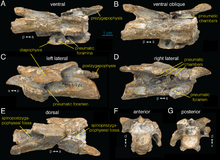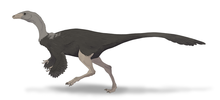| Archaeornithomimus Temporal range: Late Cretaceous, ~96 Ma PreꞒ Ꞓ O S D C P T J K Pg N ↓ | |
|---|---|

| |
| Archaeornithomimus asiaticus skeleton mounted at the Paleozoological Museum of China. | |
| Scientific classification | |
| Domain: | Eukaryota |
| Kingdom: | Animalia |
| Phylum: | Chordata |
| Clade: | Dinosauria |
| Clade: | Saurischia |
| Clade: | Theropoda |
| Clade: | †Ornithomimosauria |
| Family: | †Ornithomimidae |
| Genus: | †Archaeornithomimus Russell, 1972 |
| Species: | †A. asiaticus |
| Binomial name | |
| †Archaeornithomimus asiaticus (Gilmore, 1933) | |
Archaeornithomimus (meaning "ancient bird mimic") is a genus of ornithomimosaurian theropod dinosaur that lived in Asia during the Late Cretaceous period, around 96 million years ago in the Iren Dabasu Formation.
Discovery and naming

In 1923, during the American Museum of Natural History expedition by Roy Chapman Andrews to Inner Mongolia, Peter Kaisen discovered numerous theropod remains in three quarries. They consist of the largely disarticulated remains of several individuals and material of the skull and the lower jaws is lacking. These were named and shortly described by Charles Whitney Gilmore in 1933 as a new species of Ornithomimus: Ornithomimus asiaticus. The specific name refers to the Asian provenance. The species was placed in the new genus Archaeornithomimus by Dale Russell in 1972, making Archaeornithomimus asiaticus the type species of the genus. The generic name combines that of Ornithomimus with a Greek ἀρχαῖος (archaios), "ancient", because Russell believed that the layers in which Archaeornithomimus was found dated to the Cenomanian-Turonian ages, about 95 million years ago, making it one of the oldest ornithomimids known at the time. Gilmore had not assigned a holotype specimen; in 1990, David Smith and Peter Galton in the first comprehensive description of the fossils, choose specimen AMNH 6565, a foot, as the lectotype. The fossils were found in the Iren Dabasu Formation, which has been dated to the Cenomanian age, around 95.8 ± 6.2 million years ago.
Formerly assigned species
Foot bones found in the Early Cretaceous Arundel Formation of Maryland were referred by Othniel Charles Marsh to Allosaurus medius in 1888. In 1911, Richard Swann Lull named these as a new species of Dryptosaurus: Dryptosaurus grandis. In 1920, Gilmore renamed them to a new species of Ornithomimus. However, because Ornithomimus grandis already existed, he renamed the species Ornithomimus affinis. In 1972, Dale Russell renamed them as a second species of Archaeornithomimus (A. affinis), but other authors considered this taxon a nomen dubium in both editions of The Dinosauria. In 1990, Smith and Galton concluded that the remains were not ornithomimosaurian and came from some other small theropod, while the describers of other ornithomimosaurs (Kinnareemimus, Arkansaurus and Paraxenisaurus) suggested that "O." affinis does belong to an indeterminate ornithomimosaur.
In 1995, Nesov named a new species of ornithomimosaur from the Bissekty Formation (Turonian) of Uzbekistan as Archaeornithomimus bissektensis, based on the holotype N 479/12457, a femur of a juvenile, along with other referred specimens including the metatarsals. However, the affinity of A. bissektensis was generally doubted or not mentioned by subsequent studies. In 2025, Averianov and Sues assigned this taxon to the new genus Dzharacursor.
Description


Archaeornithomimus was a medium sized ornithomimosaur, reaching 3.4 m (11 ft) long and weighing over 71.5 kilograms (158 lb). Solid evidence coming from other ornithomimosaurian relatives suggest that Archaeornithomimus was a feathered animal, with very ratite-like feathers and equipped with a keratinous beak.
The hindlimbs were robustly built. The third metatarsal was not pinched at the upper end, so the foot was not arctometatarsalian. The cervical vertebrae are highly pneumatized with very complex internal chambers across the neural arches and the centrum (body of the vertebra), indicating the presence of cervical air sacs. The anterior dorsal and some caudal vertebrae features some degree of pneumacity, however, the sacral vertebrae are apneumatic. In a 2001 study conducted by Bruce Rothschild and other paleontologists, 229 foot bones referred to Archaeornithomimus were examined for signs of stress fracture, but none were found.
Classification

Russell assigned Archaeornithomimus to the Ornithomimidae. Recent cladistic analyses either confirm this or recover the species outside of the Ornithomimidae, basal in the Ornithomimosauria. During the description of Hesperornithoides, an extensive Coelurosauria phylogenetic analysis (also known as the Lori matrix) was conducted in order to determine the position of this paravian. Here, Archaeornithomimus was recovered within the Garudimimidae being a relative of Arkansaurus:
| Ornithomimosauria |
| ||||||||||||||||||||||||||||||||||||||||||||||||||||||||||||||||||||||||||||||||||||||||||||||||||||||||||||||||||||||||||||||||||||||||||||||||
Paleoecology

The remains of Archaeornithomimus were found in the Iren Dabasu Formation, which dates back to the Cenomanian stage about 96 million years ago during the Late Cretaceous period. The environments present on the formation were mainly large floodplain terrains with braided rivers and meanders that were connected to the ocean, supporting extensive vegetation as seen on the palaeosol development and the numerous remains from herbivorous dinosaurs such as hadrosauroids.
Like other members of the Ornithomimosauria, Archaeornithomimus was likely an omnivore equipped with a horny beak, eating everything from small mammals, to plants and fruit, to eggs, and even hatchlings of other Asian dinosaurs.
Other dinosaurs that co-existed with Archaeornithomimus in the formation included other theropods, such as Alectrosaurus, Erliansaurus, Gigantoraptor and Neimongosaurus. Herbivorous dinosaurs were represented by Bactrosaurus, Gilmoreosaurus and Sonidosaurus.
See also
References
- Gilmore, C. W. (1933). "On the dinosaurian fauna of the Iren Dabasu Formation". Bulletin of the American Museum of Natural History. 67 (2): 23–78. hdl:2246/355.
- ^ Russell, D. A. (1972). "Ostrich dinosaurs from the Late Cretaceous of Western Canada". Canadian Journal of Earth Sciences. 9 (4): 375–402. Bibcode:1972CaJES...9..375R. doi:10.1139/e72-031.
- ^ Smith, D.; Galton, P. (1990). "Osteology of Archaeornithomimus asiaticus (Upper Cretaceous, Iren Dabasu Formation, People's Republic of China)". Journal of Vertebrate Paleontology. 10 (2): 255–265. doi:10.1080/02724634.1990.10011811.
- ^ Guo, Z. X.; Shi, Y. P.; Yang, Y. T.; Jiang, S. Q.; Li, L. B.; Zhao, Z. G. (2018). "Inversion of the Erlian Basin (NE China) in the early Late Cretaceous: Implications for the collision of the Okhotomorsk Block with East Asia" (PDF). Journal of Asian Earth Sciences. 154: 49–66. Bibcode:2018JAESc.154...49G. doi:10.1016/j.jseaes.2017.12.007. Archived from the original (PDF) on 2020-09-19. Retrieved 2020-05-01.
- Marsh, O. C. (1888). "Notice of a new genus of Sauropoda and other new dinosaurs from the Potomac Formation". American Journal of Science. Series 3. 35 (205): 89–94. Bibcode:1888AmJS...35...89M. doi:10.2475/ajs.s3-35.205.89. S2CID 130879860.
- Lull, R. S. (1911). "The Reptilia of the Arundel Formation". Maryland Geological Survey: Lower Cretaceous: 173–178.
- Gilmore, C. W. (1920). "Osteology of the carnivorous dinosauria in the United States National Museum, with special reference to the genera Antrodemus (Allosaurus) and Ceratosaurus". Bulletin of the United States National Museum (110): i-159. doi:10.5479/si.03629236.110.i. hdl:10088/10107. OCLC 1836981.
- Barsbold, R.; Osmólska, H. (1990). "Ornithomimosauria". In Weishampel, D.B.; Dodson, P.; Osmólska, H. (eds.). The Dinosauria. Berkeley: University of California Press. pp. 225–244.
- Makovicky, P.J.; Kobayashi, Y.; Currie, P.J. (2004). "Ornithomimosauria". In Weishampel, D.B.; Dodson, P.; Osmólska, H. (eds.). The Dinosauria (2nd ed.). Berkeley: University of California Press. pp. 137–150.
- Buffetaut, Eric; Suteethorn, Varavudh; Tong, Haiyan (2009). "An early 'ostrich dinosaur' (Theropoda: Ornithomimosauria) from the Early Cretaceous Sao Khua Formation of NE Thailand". In Buffetaut, Eric; Cuny, G.; Le Loeuff, Jean; Suteethorn, Varavudh (eds.). Late Palaeozoic and Mesozoic Ecosystems in SE Asia. Geological Society of London. pp. 229–243. doi:10.1144/SP315.16. ISBN 978-1-86239-275-5. S2CID 128633687.
- Hunt, ReBecca; Quinn, James Harrison (March 19, 2018). "A new ornithomimosaur from the Early Cretaceous Trinity Group of Arkansas". Journal of Vertebrate Paleontology. 38: 1. doi:10.1080/02724634.2017.1421209. S2CID 90165402 – via Taylor and Francis.
- Serrano-Brañas, Claudia Inés; Espinosa-Chávez, Belinda; MacCracken, S. Augusta; Gutiérrez-Blando, Cirene; De León-Dávila, Claudio; Ventura, José Flores (2020). "Paraxenisaurus normalensis, a large deinocheirid ornithomimosaur from the Cerro del Pueblo Formation (Upper Cretaceous), Coahuila, Mexico". Journal of South American Earth Sciences. 101. Bibcode:2020JSAES.10102610S. doi:10.1016/j.jsames.2020.102610. S2CID 218968100.
- Nesov, L. A. (1995). "Dinozavri severnoi Yevrazii: Novye dannye o sostave kompleksov, ekologii i paleobiogeografii". Institute for Scientific Research on the Earth's Crust. St Petersburg State University: 1–156.
- Lee, Y.-N.; Barsbold, R.; Currie, P. J.; Kobayashi, Y.; Lee, H.-J.; Godefroit, P.; Escuillié, F.; Chinzorig, T. (2014). "Resolving the long-standing enigmas of a giant ornithomimosaur Deinocheirus mirificus". Nature. 515 (7526): 257–260. Bibcode:2014Natur.515..257L. doi:10.1038/nature13874. PMID 25337880. S2CID 2986017.
- ^ Watanabe, A.; Gold, M. E. L. G.; Brusatte, S. L.; Benson, R. B. J.; Choiniere, J.; Davidson, A.; Norell, M. A. (2015). "Vertebral Pneumaticity in the Ornithomimosaur Archaeornithomimus (Dinosauria: Theropoda) Revealed by Computed Tomography Imaging and Reappraisal of Axial Pneumaticity in Ornithomimosauria". PLOS ONE. 10 (12): e0145168. Bibcode:2015PLoSO..1045168W. doi:10.1371/journal.pone.0145168. PMC 4684312. PMID 26682888.
- ^ Hartman, S.; Mortimer, M.; Wahl, W. R.; Lomax, D. R.; Lippincott, J.; Lovelace, D. M. (2019). "A new paravian dinosaur from the Late Jurassic of North America supports a late acquisition of avian flight". PeerJ. 7: e7247. doi:10.7717/peerj.7247. PMC 6626525. PMID 31333906.
- Averianov, A. O.; Sues, H.-D. (2025). "A new ornithomimid theropod from the Upper Cretaceous Bissekty Formation of Uzbekistan". Journal of Vertebrate Paleontology. e2433759. doi:10.1080/02724634.2024.2433759.
- Holtz, T. R.; Rey, L.V. (2007). Dinosaurs: The Most Complete, Up-to-Date Encyclopedia for Dinosaur Lovers of All Ages. Random House. ISBN 9780375824197.
{{cite book}}: CS1 maint: date and year (link) Genus List for Holtz 2012 Weight Information - Chinzorig, Tsogtbaatar; Cullen, Thomas; Phillips, George; Rolke, Richard; Zanno, Lindsay E. (2022-10-19). "Large-bodied ornithomimosaurs inhabited Appalachia during the Late Cretaceous of North America". PLOS ONE. 17 (10). e0266648. doi:10.1371/journal.pone.0266648. PMC 9581415. PMID 36260601.
- Zelenitsky, D. K.; Therrien, F.; Erickson, G. M.; DeBuhr, C. L.; Kobayashi, Y.; Eberth, D. A.; Hadfield, F. (2012). "Feathered Non-Avian Dinosaurs from North America Provide Insight into Wing Origins". Science. 338 (6106): 510–514. Bibcode:2012Sci...338..510Z. doi:10.1126/science.1225376. PMID 23112330. S2CID 2057698.
- Van der Reest, A. J.; Wolfe, A. P.; Currie, P. J. (2016). "A densely feathered ornithomimid (Dinosauria: Theropoda) from the Upper Cretaceous Dinosaur Park Formation, Alberta, Canada". Cretaceous Research. 58: 108–117. doi:10.1016/j.cretres.2015.10.004.
- ^ Norell, M. A.; Makovicky, P. J.; Currie, P. J. (2001). "The beak of ostrich dinosaurs". Nature. 412 (6850): 873–874. doi:10.1038/35091139. PMID 11528466. S2CID 4313779.
- ^ Barrett, P. M. (2005). "The diet of ostrich dinosaurs (Theropoda: Ornithomimosauria)". Palaeontology. 48 (2): 347–358. doi:10.1111/j.1475-4983.2005.00448.x.
- Rothschild, B.; Tanke, D. H.; Ford, T. L. (2001). "Theropod stress fractures and tendon avulsions as a clue to activity". In Tanke, D. H.; Carpenter, K.; Skrepnick, M. W. (eds.). Mesozoic Vertebrate Life. Indiana University Press. pp. 331–336. ISBN 9780253339072.
- ^ Van Itterbeeck, J.; Horne, D. J.; Bultynck, P.; Vandenberghe, N. (2005). "Stratigraphy and palaeoenvironment of the dinosaur-bearing Upper Cretaceous Iren Dabasu Formation, Inner Mongolia, People's Republic of China". Cretaceous Research. 26 (4): 699–725. doi:10.1016/j.cretres.2005.03.004.
- Averianov, A.; Sues, H. (2012). "Correlation of Late Cretaceous continental vertebrate assemblages in Middle and Central Asia" (PDF). Journal of Stratigraphy. 36 (2): 462–485. S2CID 54210424. Archived from the original (PDF) on 2019-03-07.
- Funston, G. F.; Currie, P. J.; Ryan, M. J.; Dong, Z.-M. (2019). "Birdlike growth and mixed-age flocks in avimimids (Theropoda, Oviraptorosauria)". Scientific Reports. 9 (18816): 18816. Bibcode:2019NatSR...918816F. doi:10.1038/s41598-019-55038-5. PMC 6906459. PMID 31827127.
- Xing, H.; He, Y.; Li, L.; Xi, D. (2012). "A review on the study of the stratigraphy, sedimentology, and paleontology of the Iren Dabasu Formation, Inner Mongolia". In Wei, D. (ed.). Proceedings of the Thirteenth Annual Meeting of the Chinese Society of Vertebrate Paleontology (in Chinese). Beijing: China Ocean Press. pp. 1–44.
| Taxon identifiers | |
|---|---|
| Archaeornithomimus | |














